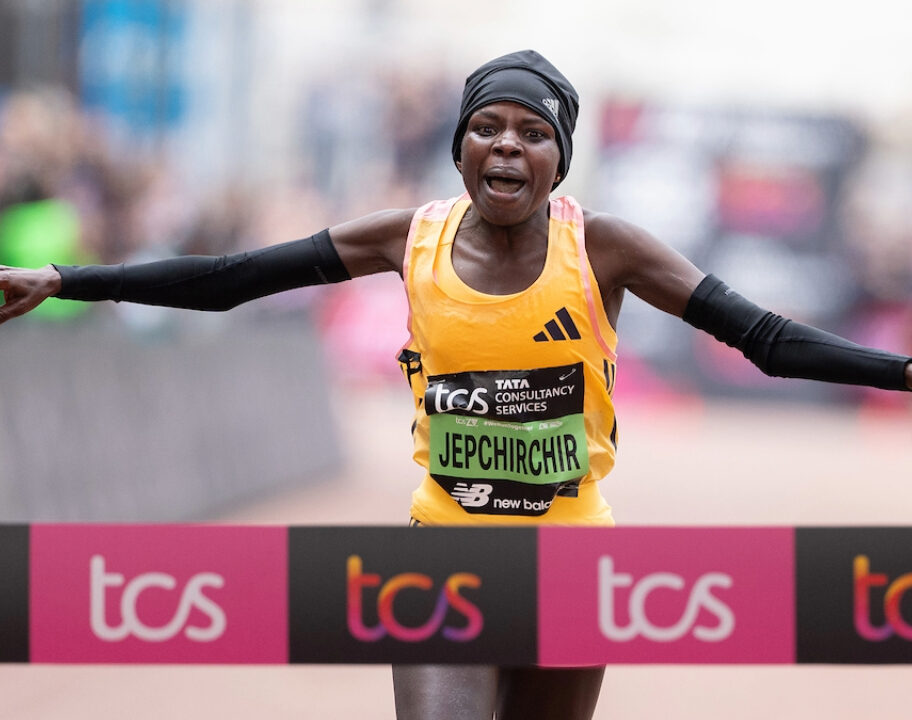Health and fitness wearables have given us access to more metrics about our sports performance and overall wellbeing than ever before. From our resting and working heart rate to how well we’ve slept. Between smart running watches and wellbeing wearables, there’s an abundance of data on offer. Which is all well and good if you know what that data means, and how to use it to get the most out of your training. But otherwise, it can just become another number on a dashboard that you occasionally look at, but mostly ignore.
Heart rate can be a powerful tool for runners. Let’s take a deeper dive into what running heart rate zones mean, and how to use that data to dial in your training, get the most out of your run workouts and pace yourself to perfection come race day.
Why run to heart rate?
Heart rate is a really valuable data point to make sure you’re working at the prescribed intensity during a run workout. Or to ensure you’re not ‘overcooking it’ and setting off too fast in the early stages of a race.
Unlike pace, which doesn’t account for how fatigued your body is on any given day. Or how environmental factors like heat and humidity might be impacting your performance. Heart rate gives a real time measure of how hard your body is having to work to sustain the effort – so you can adjust accordingly.
Get the intended training effect out of run workouts
Different styles of run workouts will be designed to stimulate different energy systems (i.e. training zones). The aim of a run workout with 3 x 15 minutes at Zone 3 intensity, for example, will be designed to raise your first lactate threshold (LT1) to work on your marathon pace. Whereas short Zone 6 intervals will be designed to boost your VO2 max. Your training program will be carefully designed to balance load and fatigue. So it’s important to make sure you’re working at the prescribed intensity to A) get the desired training adaptation out of the session. And B) ensure you’re not putting unnecessary fatigue into your body that could contribute to increasing injury risk.
Target pace is one way to do this. But that won’t factor in how factors beyond your training load – such as sleep, stress levels, nutrition – are impacting your body. Using heart rate means you can adjust the pace to work at the correct intensity level on any given day. Sometimes you might be able to go faster than the target pace for the same effort. Other days, you might be fatigued and need to scale back.
Manage your race pace
Pacing is key for any running distance. But particularly once you step up to the half marathon and marathon distances, setting off at the appropriate pace can be make or break for your race. Running to heart rate will help you to avoid the all too common runner’s error of getting swept up in the excitement and going off way too fast at the start of the race – resulting in an epic blow up in the closing miles, and a slower overall finish time than you’re capable of.

On the flip side, heart rate can also be useful to make sure you’re not leaving any performance out there. Once you’ve rested and tapered, you might actually be able to run faster than you think. So if you run to pace alone, you could risk not fully achieving your potential. Using pace and heart rate in tandem will help you to run at your full potential on race day.
What heart rate should I be running at? Heart rate zones and how to calculate yours
So that’s why heart rate is such a useful tool for runners. But how do you know what heart rate to target? There’s no such thing as a one size fits all ‘ideal heart rate’ for running. That number will change for every individual, depending on factors including age and fitness level. And the length and intensity of the run you’re doing. The heart rate you’d target for a 5km is going to be drastically different to the average heart rate you’d hold for a 100km ultra!
This is why most run training programs and running coaches will use heart rate zone to indicate intensity when prescribing sessions and setting race plans. These are based on percentages, which you individualise to give yourself a target range using your maximum heart rate.
What is maximum heart rate and how do I calculate mine?
Maximum heart rate is the highest number of beats per minute (bpm) your heart can safely sustain during maximum stress. We use maximum heart rate (MHR) to calculate heart rate zones – the higher percentage of your MHR that you’re working at, the higher the intensity of the run workout.
You might have come across the 220 minus your age equation to estimate maximum heart rate. But it’s now recognised that this equation, while giving a very rough ball park estimate, doesn’t factor in things like your genetics, fitness level and sex – which has an impact on accuracy. Physiology and fitness will both have an impact on your MHR.
How to test max heart rate
Instead, the best way to find your max heart rate is to perform an exercise test. If you want the most accurate measure possible, there are dedicated exercise and physiology labs you can visit to get tested under controlled conditions.
But otherwise you can find your maximum heart rate by running a 5km as fast as you can (or looking at your most recent 5km PB if you wore a heart rate monitor) and recording your heart rate. The highest number of bpm you reached during that 5km effort will be a fairly accurate indication of your current maximum heart rate, as long as you really gave it your all. Make sure you’re well rested before completing your 5km test to get a real indication of where you’re at. And if you have any health concerns – always check with your doctor/medical professional before taking on any intense activities!
Heart rate zones and how to use them to dial in your run training
There are a few difference ‘zone’ structures around, but for this article we’ll be working to a six zone model. Below you’ll find a summary of each heart rate zone – including the target percentage range of your max heart rate for each zone. Plus some details on the training effect of each zone to help you dial in your run workouts and get the desired benefit depending on your training goals.
Description:
Active recovery
% max heart rate:
50-60%
Training effect/benefits:
Warm ups, cool downs and active recovery. Stimulates blood flow to the muscles, helping to prepare them for activity prior to a workout, or helping to speed up the removal of waste products and the delivery of oxygen and repair agents post-workout to aid recovery.
Description:
Endurance
% max heart rate:
60-70%
Training effect/benefits:
Develops aerobic fitness by improving cardiovascular efficiency. Low intensity Zone 2 activity helps your body to get more efficient at oxygen delivery and uptake, promotes better fat oxidisation and the use of lactate as a fuel source. This raises your first lactate threshold, enabling you to run faster for longer before the onset of fatigue.
Description:
Steady
% max heart rate:
70-80%
Training effect/benefits:
Lactate clearance. At Zone 3 intensity, we generally hit our first lactate threshold which aligns with marathon race pace. Longer intervals (~15 minutes) at Zone 3 intensity will help your body to get better at holding your target marathon pace.
Description:
Tempo
% max heart rate:
85%
Training effect/benefits:
Working in the ‘comfortably uncomfortable’ sweet spot, Zone 4 effort aligns with your 10km pace. Intervals at this intensity will help to raise your 2nd lactate threshold. 8-10 minute reps at Zone 4 are a solid bang for your buck workout to boost your run fitness. Particularly useful for marathon training because this intensity won’t put a huge amount of fatigue into your body – ideal when you’re fitting in higher mileage.
Description:
Threshold
% max heart rate:
85-95%
Training effect/benefits:
Threshold means you’re working at the very top end of your aerobic capacity. Zone 5 work typically aligns with your 5km all-out race pace. Shorter intervals (3-5 minutes) at this intensity will help to improve your 5km time and boost your run speed.
Description:
VO2 Max
% max heart rate:
>95%
Training effect/benefits:
VO2 Max refers to the maximum amount of oxygen you are able to take up and use. Zone 6 efforts typically last at most 1-2 minutes depending on fitness levels – think short track intervals. Zone 6 work provides a serious run fitness boost, raising the ceiling on your aerobic fitness. But it’s tough on the body, so plan these sessions carefully around your other training and factor in recovery time to let the adaptations soak in.
For endurance runners, a significant proportion of training (typically 80%) will be completed at Zone 2 intensity to build your aerobic engine. But adding in a variety of speed work, alongside incorporating some shorter stints of race pace work into your long runs, can be seen as the ‘cherry on the cake’ (or the carbon in your race shoes!) to help you improve your speed over longer distances.
How to lower heart rate while running
Many runners find running to heart rate frustrating at first because sticking within the prescribed heart rate zones – particularly for easy endurance runs – often means slowing down. Many of us are guilty of pushing the pace a little too much on our ‘easy’ runs. Which means while we might think we’re in Zone 2, we’re actually creeping up into Zone 3. Over time, that not only means you’re missing out on all benefits of Zone 2 training. It also means you’re putting more fatigue than necessary into your legs – meaning it’s likely you don’t have the energy to go hard enough during your intentionally hard sessions.
If you can trust the process, you’ll soon find your heart rate starts to get lower while you’re running. One of the many benefits of Zone 2 training is that it stimulates adaptations that make your body far more efficient at delivering and using oxygen, using fat as a fuel source, and clearing lactate. All of that means you’ll be able to run faster, for less effort. Your easy, Zone 2 pace will improve over time.
Form and recovery
The other factors to consider when it comes to bringing your heart rate down while running are form, efficiency and recovery. If you’re running with inefficient form, every stride is taking more effort than necessary. This will increase the demands on your cardiovascular system. Take a look at our guide to running form and economy to get some tips to become a more efficient runner.

It’s also important to prioritise recovery between training sessions to give your body the chance to adapt to the stimulus and become a more efficient machine. If you’re noticing that, despite consistent steady state training, your heart rate is higher than usual during run sessions. This may be a sign that your body is over-fatigued. Make sure you’re taking regular rest days and prioritising a balance intake rich in wholegrain carbohydrates and protein.
Quick-fire recap/FAQs
Measuring your heart rate gives you an indication of how hard you’re working, so you can ensure you train at the correct intensity using running heart rate zones. Tracking your heart rate during your run training over time can also be used as a way of measuring improvements in your run fitness. As you get fitter, you’ll be able to run faster at a lower heart rate.
Use a heart rate monitor to track your heart rate. You can choose from a chest strap or an arm band (we like both the Wahoo Tickr and the Coros armband). Some running watches also have wrist-based heart rate.
Your target heart rate depends on your max heart rate and the type of session you’re doing. For endurance runs, aim to stick within 60-70% of your max heart rate. For higher intensity sessions such as intervals you’d work at a higher percentage – around 80% for longer intervals, >95% for short intervals.
A high heart rate could be down to a lack of run fitness. Slow your pace (even if that means some walking). As your fitness improves, you’ll be able to run faster at a lower heart rate. If you’re an experienced runner and your heart rate is unusually high during a run, this could be down to hot weather conditions or a sign you’re carrying illness. Beginner or experienced runner, if you have any concerns about your heart rate (during exercise or at rest) you should always seek medical advice as first port of call.
RELATED: Interval workouts for marathon training: why speed work is still key when going long
Note: when you purchase through some links on our site, we may earn a small affiliate commission.


![Russ Cook completes his epic run across the entire length of Africa [Photo credit: The Snapshot People Ltd]](https://run247.com/wp-content/uploads/2024/04/Russ-Cook-completes-length-of-Africa-run-2024-912x720.jpg)



